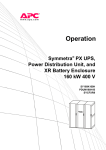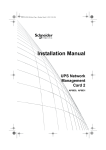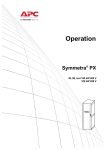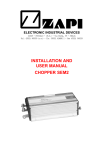Download APC SmartSlot AP9604SR Operating instructions
Transcript
Thank You! Thank you for selecting this American Power Conversion SmartSlot Series Relay I/O Module UPS accessory. It has been designed for many years of reliable, maintenance-free service. Please read this manual! It provides installation and operating instructions that will help you get the most from your accessory. Save this manual! It includes important instructions for the safe installation of your accessory. Further, it includes instructions for obtaining factory service. Radio frequency interference Warning: Changes or modifications to this unit not expressly approved by the party responsible for compliance could void the users authority to operate the equipment. Note: This equipment has been tested and found to comply with the limits for a Class B digital device, pursuant to Part 15 of the FCC Rules. These limits are designed to provide reasonable protection against harmful interference in a residential installation. This equipment generates, uses and can radiate radio frequency energy and, if not installed and used in accordance with the instructions, may cause harmful interference to radio communications. However, there is no guarantee that interference will not occur in a particular installation. If this equipment causes interference to radio or television reception, which can be determined by turning the equipment off and on, the user is encouraged to try to correct the interference by one or more of the following measures: • reorient the receiving antenna • increase the separation between the equipment and the receiver • connect the equipment into an outlet on a circuit different from that to which the receiver is connected • consult the dealer or an experienced radio/TV technician for help. Shielded communications interface cables must be used with this product to ensure compliance with Class B FCC limits. This digital apparatus does not exceed the Class B limits for radio noise emissions from digital apparatus set out in the Radio Interference Regulations of the Canadian Department of Communications. Entire contents copyright © 1995 American Power Conversion. All rights reserved. Reproduction in whole or in part without written permission is prohibited. SmartSlot and the stylized APC logo are trademarks of APC. All other trademarks are property of their respective owners. Contents 1 Introduction . . . . . . . . . . . . . . . . . . . . . . . . . . . . . . . . . . . . . . . . . 1 2 Configuration . . . . . . . . . . . . . . . . . . . . . . . . . . . . . . . . . . . . . . . . 2 3 Operation Check . . . . . . . . . . . . . . . . . . . . . . . . . . . . . . . . . . . . . . 4 4 Operating Considerations . . . . . . . . . . . . . . . . . . . . . . . . . . . . . . . 5 5 Final Installation . . . . . . . . . . . . . . . . . . . . . . . . . . . . . . . . . . . . . . 6 6 Connection Strategies . . . . . . . . . . . . . . . . . . . . . . . . . . . . . . . . . . 8 7 Dry Contact I/O Pinout. . . . . . . . . . . . . . . . . . . . . . . . . . . . . . . . . 9 8 Accessory Connection Board . . . . . . . . . . . . . . . . . . . . . . . . . . . 10 9 Troubleshooting . . . . . . . . . . . . . . . . . . . . . . . . . . . . . . . . . . . . . 11 10 Service . . . . . . . . . . . . . . . . . . . . . . . . . . . . . . . . . . . . . . . . . . . . 12 11 Specifications . . . . . . . . . . . . . . . . . . . . . . . . . . . . . . . . . . . . . . . 13 12 Declaration of Conformity . . . . . . . . . . . . . . . . . . . . . . . . . . . . . 14 1. Introduction The APC SmartSlot Relay I/O Module is a SmartSlot Series UPS accessory that provides the following features: • UPS status information presented as six form C contact closures • UPS control and testing by contact closure inputs • Screw terminal connectors for easy integration into various management systems. Description The SmartSlot Relay I/O Module consists of a printed circuit board assembly (right below), and an accessory connection board (left below). The SmartSlot Relay I/O Module installs in the SmartSlot of the host device. The connector board, which has the screw terminals for making connections to the SmartSlot Relay I/O Module, attaches to the installed I/O module (see section 5). 3 Configuration Switch Figure 1, SmartSlot Relay I/O Module Note the location of the configuration switches on the printed circuit board in figure 1 above. 2. Configuration Switch setting The SmartSlot Relay I/O Module requires configuration before testing, final installation, and use. Note: While the SmartSlot Relay I/O Module has a four position DIP configuration switch (marked CONFIG SWITCH on the printed circuit board— see figure 1), only position 1 is used. The other switches must be left in the off position. Move the switch up for ON and down for OFF. Configuration 1 is intended for use with UPSs that do not include a bypass feature (like Smart-UPS). Configuration 2 is intended for use with UPSs that include a bypass feature (like Matrix-UPS). Choose from configuration 1 and configuration 2 in the table below. Set CONFIG SWITCH position 1 as required. Input/Output Configurations Input/ Output Configuration 1 (CONFIG SWITCH 1 off) Configuration 2 (CONFIG SWITCH 1 on) Input #1 Turn the UPS on Input #2 Turn the UPS off Input #3 Start UPS self-test Input #4 Shut down the UPS (when onbatter except during a self-test or run time calibration) Put the UPS in bypass (if available on the UPS) Output #1 The UPS is on-battery (e.g., during a power failure, self-test, or run time calibration) Output #2 UPS has a low battery Output #3 The protected load is not receiving power from the UPS or communication between the UPS and the Relay I/O Module has been lost Output #4 Replace the UPS battery Output #5 Output #6 The UPS is overloaded The UPS is in bypass by software, front panel, rear panel selection Any UPS fault or self-test failure Any UPS fault, self-test failure, or overload 3. Operation Check Check the operation of the SmartSlot Relay I/O Module before final installation. Note: The UPS will not protect the load during this procedure. 1. Check the output relays by temporarily installing the SmartSlot Relay I/O Module into the SmartSlot. See section 4 for information on installing the SmartSlot Relay I/O Module in the SmartSlot. Attach the supplied screw terminal connection board. 2. Turn on the UPS. Wait for a few seconds for the SmartSlot Relay I/O Module to initialize. Use a digital multimeter or continuity checker to confirm that all N. O. (normally open) output contacts are open and that all N. C. (normally closed) contacts are shorted. Measure resistance from each common contact to the corresponding N. O. and N. C. contacts. Short circuit resistance should be near 0 Ohms, while open circuit resistance should be greater than 1 megaohm. 3. Remove the SmartSlot Relay I/O Module from the SmartSlot and confirm that all outputs have changed states—that all N.O. contacts are shorted and that all N. C. contacts are open with respect to their common contacts. 4. Turn the UPS off. Check the inputs by temporarily installing the SmartSlot Relay I/O Module into the SmartSlot. Attach the supplied screw terminal connection board. 5. Short circuit input #1 to one of the ground contacts on the screw terminal connection board. Confirm that the UPS turns on. Note: Valid SmartSlot Relay I/O Module inputs require continuous assertion for at least one second. 6. Short circuit input #2 to ground. Confirm that the UPS turns off. 7. Turn the UPS on and wait for the self-test to complete. Short circuit input #3 to ground. Confirm that the UPS performs a self-test. 8. Disconnect the UPS from the AC power source. Short circuit input #4 to ground. Confirm that the UPS enters sleep mode (this requires from 20 to 600 seconds, depending on internal UPS settings). Reconnect the AC power source to the UPS. 4. Operating Considerations Note: While the SmartSlot Relay I/O Module output contacts are voltage free, connected equipment may present hazardous voltages. Use care during installation. Please note the following SmartSlot Relay I/O Module characteristics when making system integration decisions: • The coils for all output relays are normally energized. This means that the SmartSlot Relay I/O Module will generate all possible alarms in case of a system fault, such as cable failure, SmartSlot Relay I/O Module removal, severe UPS battery discharge, or catastrophic hardware failure on the module. • All output contacts are isolated from each other and from UPS system ground. Note: The outputs are not intended to directly switch AC loads. See table below. • Control inputs are designed to be driven by dry contact outputs. The contact closure sensing voltage available on these inputs is nominally 5 Vdc at less than 1 mA. All control inputs are referenced to UPS system ground. • In order to properly de-bounce noisy contact closures, all control inputs must be stable for at least one second to be considered valid. • Joint assertion of input #1 (turn the UPS on) and input #2 (turn the UPS off) will be ignored. • Although control inputs are acted on as soon as possible, there are several UPS conditions such as self-test or run time calibration that can cause an input to be ineffective. For confirmation of inputs, observe changes in the corresponding output(s). Output Contact Ratings Parameter Value Nominal switching capacity 1 A at 30 Vdc Maximum switching power 30 W Maximum switching voltage 60 Vdc Maximum switching current 2 Adc Maximum carrying current 2 Adc Surge ratings 2 kV per Bellcore TA-NWT-001089 1.5 kV per FCC part 68 5. Final Installation 1. Use either the supplied accessory connection board or a male 25 pin D connector (not supplied) to make connections to the SmartSlot Relay I/O Module. To use a male 25 pin D connection see section 6 for the connector pinout. To use the supplied accessory connection board see figure 2 below. Note the use of tie wraps to secure the connecting wires to the board. The connection board accepts 16 AWG to 28 AWG wires. Figure 2, accessory connection board wire dress 2. 3. 4. See sections 6, 7, and 8 for information on how to set up SmartSlot Relay I/O Module input wiring. Make all connections to either the 25 pin D connector or accessory connection board before continuing. Caution! The SmartSlot Relay I/O Module is sensitive to static electricity. Handle the SmartSlot Relay I/O Module by the end plate only. Do not touch the exposed printed circuit board. While it is not possible to install the SmartSlot Relay I/O Module upside down, it is possible to damage it in the attempt. Observe the correct orientation of the SmartSlot Relay I/O Module as shown in figure 3. Note that the sides of the printed circuit board align with the locating slots in the sides of the SmartSlot. The SmartSlot may be oriented horizontally or vertically in the host device. The host device may be on or off. 5. Use a #2 Phillips head screwdriver to remove the two screws retaining the SmartSlot cover on the host device. Keep the screws handy for step 7 below. Keep the SmartSlot cover for future use. Figure 3, Relay I/O Module installation 6. Orient the SmartSlot Relay I/O Module to fit in the SmartSlot as shown. Slide the SmartSlot Relay I/O Module all the way into the slot until the end plate is flush with the back panel of the host device. 7. Secure the SmartSlot Relay I/O Module with the screws removed in step 5. 8. Attach and secure either the accessory connection board or 25 pin D connector as prepared in step 1. 6. Connection Strategies The alarm outputs of the SmartSlot Relay I/O Module can be connected in a number of ways to meet the needs of the management system. Both N. O. or N. C. systems are accommodated in any combination of AND or OR configurations. It is possible, then, to combine SmartSlot Relay I/O Module alarm outputs to form compound outputs like replace battery OR fault, or on-battery AND low battery. See figure 4. Figure 4, AND and OR alarms 7. Dry Contact I/O Pinout 13 12 11 10 9 8 7 6 5 4 3 2 1 25 24 23 22 21 20 19 18 17 16 15 14 Function Pin Function Pin N. O. output #1 (NO1) 1 N. O. output #2 (NO2) 14 Output #1 common 2 Output #2 common 15 N. C. output #1 (NC1) 3 N. C. output #2 (NC2) 16 N. O. output #3 (NO3) 4 N. O. output #4 (NO4) 17 Output #3 common 5 Output #4 common 18 N. C. output #3 (NC3) 6 N. C. output #4 (NC4) 19 N. O. output #5 (NO5) 7 N. O. output #6 (NO6) 20 Output #5 common 8 Output #6 common 21 N. C. output #5 (NC5) 9 N. C. output #6 (NC6) 22 Control input #4 10 Ground 23 Control input #3 11 Ground 24 Control input #2 12 Ground 25 Control input #1 13 Ground Shell 8. Accessory Connection Board 9.Troubleshooting Problem Possible Cause Solution The SmartSlot relay I/O Module does not respond to control inputs. Insufficient setup or hold times. Configure controlling equipment to provide at least one second of alarm hold. See section 4. Invalid or intermittent alarms. Poor contact at either the dry contact I/O connector or the accessory connection board. Correct poor contact conditions. Tighten all connector screws. Alarms always on or will not come on. Relay welded. Return the SmartSlot Relay I/O module for service. See section 10. The SmartSlot Relay I/O Module has failed. See section 10 for customer service information. The SmartSlot Relay I/ O Module does not generate alarms. Other accessories attached to the computer interface port of the UPS stop working. 10. Service If the SmartSlot Relay I/O Module requires service: 1. Check the SmartSlot Relay I/O Module using the troubleshooting chart in section 9 before calling for service. 2. Note the model number of the SmartSlot Relay I/O Module, the serial number, and the date purchased. See the back cover of this manual for the correct telephone number and call customer service. A technician will ask you to describe the problem and help solve it over the phone, if possible, or will give you an RMA#. If customer service is not available in your area, call the dealer that sold the SmartSlot Relay I/O Module. If the SmartSlot Relay I/O Module is under warranty, repairs are free. If not, there will be a charge for repair. 3. Pack the SmartSlot Relay I/O Module in its original packaging, if possible. Damage sustained in transit is not covered under warranty. 4. Include a letter with your name, RMA#, address, copy of the sales receipt, description of the trouble, your daytime phone number, and a check (if necessary). 5. Mark the RMA# on the outside of the package. The factory cannot accept any package without this marking. 6. Return the SmartSlot Relay I/O Module by insured, prepaid carrier to the address given by the technician. 11. Specifications Electrical SmartSlot specification compatible Operating voltage: 16–27 Vdc Operating current draw: 70 mAdc Physical Size (H x W x D): 4 x 4 x 1.5 inches (10.2 x10.2 x 3.8 cm) Weight: 0.3 lb. (140 gm) Shipping weight: 0.7 lb. (320 gm) Environmental Operating elevation (storage): 0 to 3,000 m (0 to 15,000 m) Operating temp. (storage): 0 to 40 °C (0 to 45 °C) Approvals EMC verification: FCC Class B, DOC class B, EN55022 Class B Electromagnetic immunity: EN50082-1 verified 12.Declaration of Conformity Application of Council Directives: 89/336/EEC Standards to Which Conformity is Declared: EN55022, EN50082-1 Manufacturer’s Name: American Power Conversion 132 Fairgrounds Road West Kingston, RI 02892 USA Importer’s Name and Address: Type of Equipment: SmartSlot Relay I/O Module Model Number: AP9610 Serial Numbers: A95040000001–A961299999999 Year of Manufacture: 1995, 1996 I, the undersigned, hereby declare that the equipment specified above conforms to the above directive(s). Place: Billerica, MA USA Date: 3/31/95 Joseph Pomata, regulatory compliance engineer Limited Warranty American Power Conversion (APC) warrants its products to be free from defects in materials and workmanship for a period of two years from the date of purchase. Its obligation under this warranty is limited to repairing or replacing, at its own sole option, any such defective products. To obtain service under warranty you must obtain a Returned Material Authorization (RMA) number from APC or an APC service center. Products must be returned to APC or an APC service center with transportation charges prepaid and must be accompanied by a brief description of the problem encountered and proof of date and place of purchase. This warranty does not apply to equipment which has been damaged by accident, negligence, or misapplication or has been altered or modified in any way. This warranty applies only to the original purchaser who must have properly registered the product within 10 days of purchase. EXCEPT AS PROVIDED HEREIN, AMERICAN POWER CONVERSION MAKES NO WARRANTIES, EXPRESS OR IMPLIED, INCLUDING WARRANTIES OF MERCHANTABILITY AND FITNESS FOR A PARTICULAR PURPOSE. Some states do not permit limitation or exclusion of implied warranties; therefore, the aforesaid limitation(s) or exclusion(s) may not apply to the purchaser. EXCEPT AS PROVIDED ABOVE, IN NO EVENT WILL APC BE LIABLE FOR DIRECT, INDIRECT, SPECIAL, INCIDENTAL, OR CONSEQUENTIAL DAMAGES ARISING OUT OF THE USE OF THIS PRODUCT, EVEN IF ADVISED OF THE POSSIBILITY OF SUCH DAMAGE. Specifically, APC is not liable for any costs, such as lost profits or revenue, loss of equipment, loss of use of equipment, loss of software, loss of data, costs of substitutes, claims by third parties, or otherwise. Life support policy As a general policy, American Power Conversion (APC) does not recommend the use of any of its products in life support applications where failure or malfunction of the APC product can be reasonably expected to cause failure of the life support device or to significantly affect its safety or effectiveness. APC does not recommend the use of any of its products in direct patient care. APC will not knowingly sell its products for use in such applications unless it receives in writing assurances satisfactory to APC that (a) the risks of injury or damage have been minimized, (b) the customer assumes all such risks, and (c) the liability of American Power Conversion is adequately protected under the circumstances. Examples of devices considered to be life support devices are neonatal oxygen analyzers, nerve stimulators (whether used for anesthesia, pain relief, or other purposes), autotransfusion devices, blood pumps, defibrillators, arrhythmia detectors and alarms, pacemakers, hemodialysis systems, peritoneal dialysis systems, neonatal ventilator incubators, ventilators for both adults and infants, anesthesia ventilators, and infusion pumps as well as any other devices designated as critical by the U.S. FDA. Hospital grade wiring devices and leakage current may be ordered as options on many APC UPS systems. APC does not claim that units with this modification are certified or listed as Hospital Grade by APC or any other organization. Therefore these units do not meet the requirements for use in direct patient care.



























